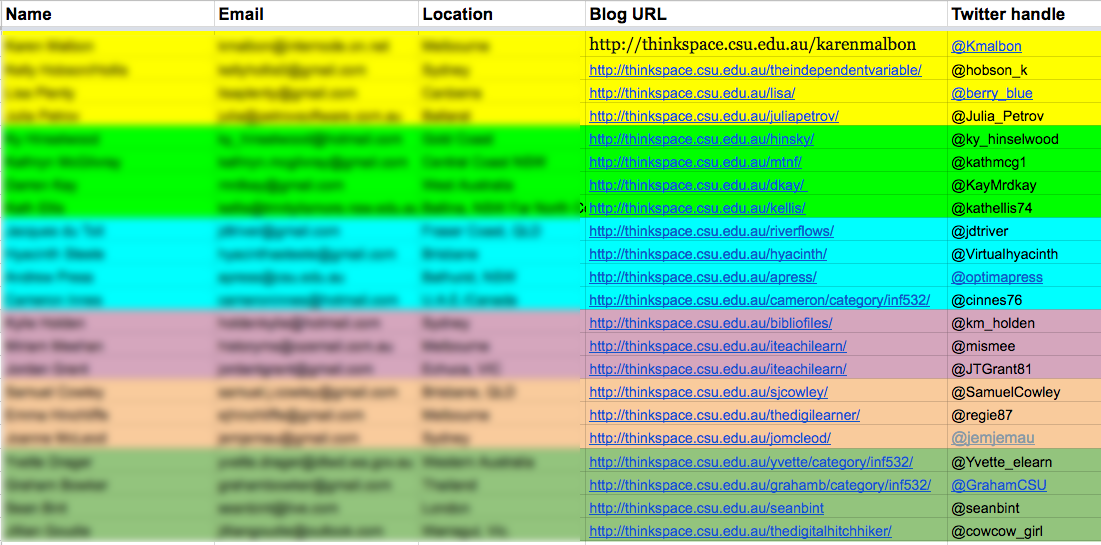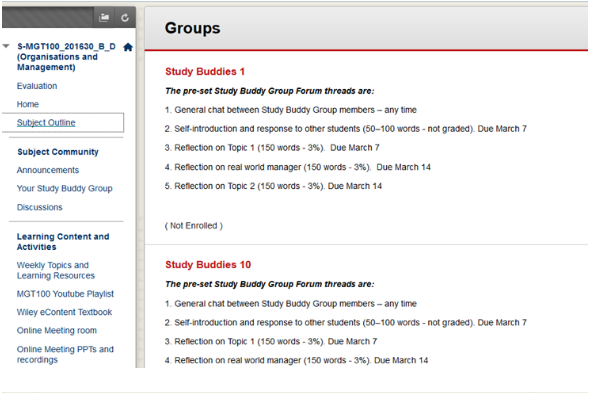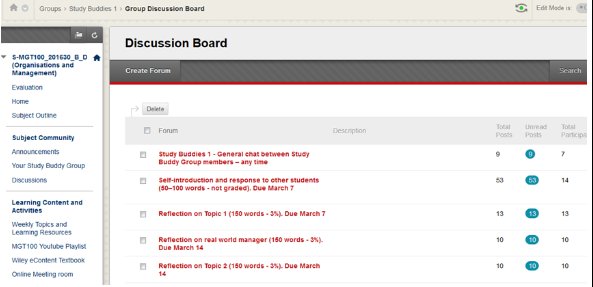Overview
Study groups may be set up as part of the administration and delivery of the subject. Large cohorts can be subdivided and students can get to know a smaller more intimate group of students. These groups may be structured or unstructured. They may work through set discussion topics which can then facilitate asynchronous activity so that students can share resources they’ve found and discuss the topics and readings. Students may also want to extend their study into synchronous settings online via video chat, instant messaging or even face to face if there is a geographic link.
Engagement
Study groups don’t have to be working on an assessment or project together, rather the aim is to provide students with a small group of other students to discuss their learning throughout the session. This reduces the anxiety of socialising and sharing with a large cohort and students feel they have more of a voice and audience to engage with.
In Practice
Subject
MGT100 Organisations and Management
Teaching Staff
Wendy Webber
Motivation
MGT 100 Organisations and Management is one of the foundational management subjects within the Faculty of Business at CSU. The Study Buddy groups were established first and foremost to address the sense of isolation that many students can feel despite being part of a cohort that numbers in the hundreds. This subject is undertaken by students from a very diverse range of courses both within CSU and our partner institutions, meaning that it can be harder for students to easily find connections to students studying in similar courses or even similar geographical locations.
Implementation
Students were grouped in ‘Study Buddy’ Groups which required them to engage with their fellow group members early in the session (prior to the first assessment) to increase their familiarity with the online learning environment and build some level of rapport with fellow students, as many students within MGT100 are entering higher education for the first time. As MGT100 has several hundred students each session, creating a sense of connectedness is an important consideration in the planning for this subject. Students were asked to complete the tasks shown in the image below within their 15 person ‘Study Buddy’ small peer group, early in the session in order to successfully complete the first assessment task.
Students were able to enrol in any one of the 20 Buddy Groups, each of which contained a group discussion board where the Student Mentor was also present in conversations and responses. By engaging students in interactions in groups of no more than 20 students in the critical early phase of session, it was aimed to lessen potential anxiety and maximise opportunity for interaction rather than feel swamped by being one of many hundreds of students.
Forum activity as a gross measurement increased from 13 threads to 114 year on year, with an increase from 116 threads to 1287 different threads. Significant rises in overall student activity (10%) increase in students who created a post along with a dramatic gross increase in students who posted (in similar size cohorts) year on year.
Subject
INF532 Knowledge Networking for Educators
Teaching Staff
Julie Lindsay
Motivation
INF532 Knowledge Networking for Educators is a subject in the postgraduate degree Master of Education in Knowledge Networks and Digital Innovation (School of Information Studies). In a class of about 20-30 students, the INF532 cohort is not large, however the use of blogging buddies in this subject grouped students for peer interaction and peer review as part of the ongoing blogging process. Rather than trying to interact and read across a large number of reflective blogs, students had 3 other ‘buddies’ - and this grouping changed mid-session to allow new buddy experiences
Implementation
At the start of the session students filled in an online Google form, sharing essential details including their ThinkSpace URL. The resulting spreadsheet, colour-coded for ease of reading, helped to put students into groups of four. This was shared with students as a ‘view only’ doc.

Guide
This student to student organisation is a valuable management strategy for large and small cohorts across all student levels, and when set up and monitored effectively, can facilitate strong student to student support systems. Providing a clear structure for students to engage is key to ensuring that students have opportunities to collaborate and improve the overall chances of success.
It is important to have a clear understanding of why and how setting up a smaller group will improve the student experience. Certain subjects and topics lend themselves to working in groups, as do certain student cohorts. The specific structure of groups is determined by the approach to teaching and learning and, ideally, assessment practices in the subject. By creating a grouping experience and structure that incorporates assessment in some way it is more likely the attention and participation of students will be garnered.
Tools
- Within Interact 2 the ‘Groups’ feature allows cohorts to be divided into smaller groupings, and within these they can discuss, share etc.
- The Interact2 Wiki can also provide an area for group work.
- Google Forms is a useful way to collect information from students. It efficiently pours data into a spreadsheet that can then be shared with students to ‘view’
- uImagine is currently developing a new tool GrouperPlus to provide a more powerful way to group students. If you would be interested in testing out the tool please feel free to get in touch.
Additional Resources
Bruner , J. (1985). Vygotsky: An historical and conceptual perspective. Culture, communication, and cognition: Vygotskian perspectives, 21-34. London: Cambridge University Press
Dillenbourg, P. (1999). Collaborative Learning: Cognitive and Computational Approaches. Advances in Learning and Instruction Series. New York, NY: Elsevier Science, Inc
Dillenbourgh, P., Baker, M., Blaye, A. & O’Malley, C. (1995). The evolution of research on Collaborative Learning. Retrieved February 19, 2008, from CSCL-A brief overview
Gokhale, A. (1995). Collaborative Learning Enhances Critical Thinking. Journal of Technology Education, 7(1). http://dx.doi.org/10.21061/jte.v7i1.a.2
Rau , W. & Heyl, B. S. (1990). Humanizing the college classroom: Collaborative learning and social organization among students. Teaching Sociology, 18, 141-155.
Rogoff, B., & Toma, C. (1997). Shared thinking: Community and institutional variations. Discourse Processes, 23(3), 471-497. http://dx.doi.org/10.1080/01638539709545000
Stacey, E. (2007). Collaborative learning in an online environment. International Journal of E-Learning & Distance Education, 14(2), 14-33. Retrieved from http://www.ijede.ca/index.php/jde/article/view/154


